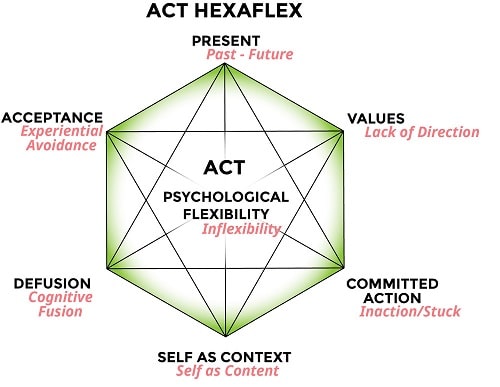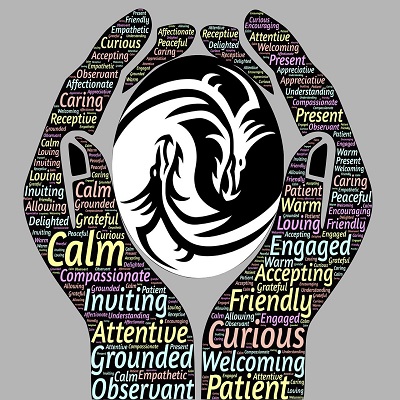Imagine a therapy that doesn’t attempt to reduce symptoms, but the symptoms eventually get reduced as its by-product. With its roots coming from the tradition of empirical science and branches touching the core values of a happy life, Acceptance, and Commitment Therapy (ACT) is challenging the foundations of western psychology. ACT has proven effective in various clinical conditions such as OCD, depression, workplace stress, chronic pain, PTSD, anxiety, heroin abuse, and even schizophrenia.
The goal of Acceptance and Commitment Therapy is to create a meaningful and productive life while accepting all the pain that goes with it. Today, in this article, we will discuss the working methodology of ACT.
So, what are you waiting for? Scroll Down!
6 Core Processes of Acceptance and Commitment Therapy

1. Accept the world as it is
On a foundation level, there are six basic emotions a person gets to experience- Happiness, Sadness, Anger, Fear, Disgust, and Surprise. Out of these six emotions, four are negative, which means two-third of the human feelings are not joyous. Acceptance, being the first core process of ACT, helps individuals accept these emotions as an inevitable part of life.
Often, this process is misunderstood. Acceptance is never about passively accepting whatever is happening; instead, it teaches a calmer way of living, regardless of how unpleasant it is. Therefore, next time you find yourself struggling with your emotions, instead of losing your calm, sit down, and observe your thoughts. Inevitably, it’s a difficult step, but dropping your resistance against challenging emotions will open the doors to a healthier life.
2. Know your Values
Values form the foundation of your life. They determine what you want your life to be about and steer you in a meaningful direction.
However, a distinction is to be made between goals and values. Often, both of these terms are used interchangeably.
Values determine the direction you have to proceed, while goals are what you hope to accomplish. For instance, “being honest” and living “ a lovable life” are values; “losing eight pounds” can be your goal.
Consider asking yourself the following questions to help explore your values-
- What kind of person do I want to be?
- Where do I stand in life?
- What does happiness mean to me?
- How do I want to behave?
3. Live in the Present

According to a recent Harvard study, an average person spends 47% of the time in their thoughts instead of being in the moment. People who face this situation scrutinize events from the past and worry about the future that hasn’t arrived yet. Fantasizing the future- a unique trait amongst humans is a huge reason for unhappiness. ACT emphasizes awareness of the physical world instead of the psychological world within you.
For being mindful, incorporate a deep breathing routine. Observe your surroundings be it the chitter-chatter of birds or the thoughts that overwhelm your mind. Learning to be in the moment is another crucial step to a meaningful life.
4. Watch your thoughts with Defusion
The human brain is the greatest boon, as well as a curse.
It is filled with powerful thoughts that can later become ideas that may eventually transform into life-changing actions. However, when these thoughts aren’t checked they can affect your overall sense of wellbeing.
Watch those constant ramblings and try observing them as stories instead of facts. We, as human beings, are practiced to see the world through a distorted lens.
Practice diffusion, detach from negative thoughts instead of getting caught in their loop.
This simple act of being a bystander, instead of buying into their truth will allow you to understand your deep-rooted thought patterns better.
5. Pay attention toThe Observing Self
Human beings have two parts of the mind- The Thinking Self & The Observing Self (Self-as-Context).
The former deals with thoughts, beliefs, memories, and judgments; the latter gives the awareness of what we are thinking, feeling, or sensing at the moment. Often, we are only aware of our thinking part and let it dominate us. ACT emphasizes the observing self (also known as self-as-context) for taking us to a place where we observe any experience without getting damaged by it. It teaches one how to observe challenging emotions without getting trapped by them.
6. Time for some Committed Action
So, here we are, on the final step of ACT- Committed Action. Whatever work was done in the above five steps was to guide you towards this one. By staying mindful and developing awareness of thoughts, one can determine the actions to be taken that are aligned with values. Shift your perspective towards a healthier and calmer lifestyle, instead of getting obsessed with negativities. And finally, don’t overwhelm yourself. Long roads are often covered with tiny steps.
Great things are not done by impulse, but by a series of small things brought together.
Vincent Van Gogh
Happy Living!




